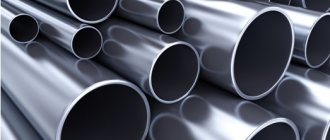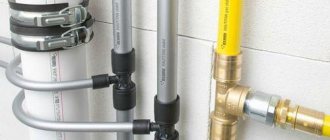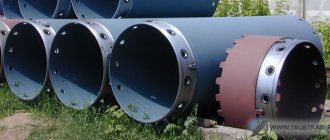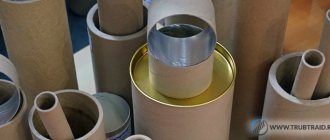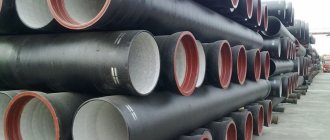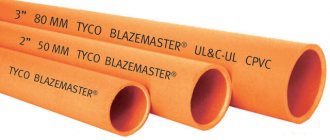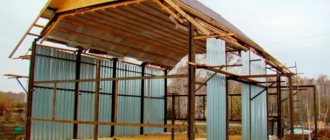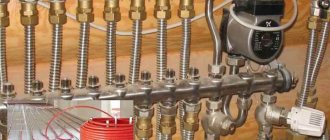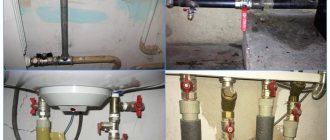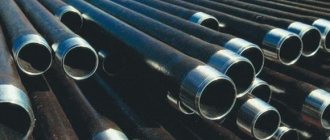Despite the fact that the construction market is filled with plastic pipes, the cast iron version of products is still in demand. Their new quality level is ensured by special additives, thanks to which the pipes become more durable.
Although socket cast iron parts are among the oldest cast iron pipe products, their popularity has only grown over the years. They have earned such respect for their high anti-corrosion properties, as well as a long service life.
You should know that with the help of bitumen, special mastics, cement-sand mortars, additional anti-corrosion protection is provided, which helps to increase the service life.
When using cast iron pressure socket pipes GOST 9583 - 75, the network of underground water mains is constantly increasing. But to be honest, the cast-iron socket pressure pipe (CHP) is inferior to its plastic counterparts in the domestic sphere, for example, when laying indoor water pipes. This is due, first of all, to their low aesthetics.
Quality assurance
When purchasing socket-shaped products made of cast iron, they must be accompanied by a certificate (pictured) - a document confirming the quality of the product.
It should contain information about:
- manufacturer;
- the customer, indicating the official name;
- numbers of batches and standards;
- the exact name of the part, as well as its parameters;
- test pressure, other data obtained during testing.
As a conclusion, this document must indicate the compliance of socket parts made of cast iron with GOST standards.
Conclusion
Don't be intimidated by seemingly abstruse and confusing documents. In any case, it is better to familiarize yourself with them. We can conclude that the cast iron products produced still have their consumers, which means there will always be new offers from manufacturers. And with these proposals it’s already worth understanding which are high-quality and which are not.
Sources
- https://trubaspec.com/vidy-trub/kharakteristiki-trub-vchshg-osobennosti-proizvodstva-i-ispolzovaniya.html
- https://gidroguru.com/trubi/materialy/chugun/2232-chugunnaya-vodoprovodnaya-truba-po-gostu-9583-75
- https://ProTryby.ru/sortament-chugunnyh-rastrubnyh-napornyh-trub
- https://trubinfo.ru/chugunnye/diametry-chugunnyh-trub.htm
- https://TrubaMaster.ru/vodoprovodnye/truby-chugunnye-kanalizacionnye-gost.html
- https://o-trubah.com/materialy/chugunnye/vchshg-truba/
- https://TrubyGid.ru/ves-chugunnoj-truby
[collapse]
Application area
The bell-shaped version of the products is used for:
- installation of sewer systems, as well as for water pipelines used to equip communication residential and industrial facilities;
- construction of pressure pipelines;
- fire protection and heat supply;
- installation of oil pipelines;
- creation of highways serving the chemical and mining industries.
For domestic purposes, pressure socketed cast iron pipes of 100 mm are used more often than others, and to a lesser extent - 200. Their price is relatively high, but this disadvantage is fully compensated by high quality and long service life (60-80 years!).
Advantages of cast iron products
The characteristics of non-pressure and pressure materials are almost the same:
- — guaranteed service life of 80 years;
- - the smallest percentage of pipeline accidents when compared with any other material;
- — constancy of the characteristics of the transported medium, including drinking water;
- — high rates of ductility, resistance to mechanical stress (impacts) and wear;
- — resistance to hydraulic shock reaches 550 N/mm²;
- — high noise insulation performance;
- — possibility of laying to a depth of up to 10 meters;
- — ability to withstand temperatures down to -60°C;
- — quick and uncomplicated installation, the ability to lay in an arc without the use of connecting elements;
- — low installation and maintenance costs;
- - Possibility of complete recycling.
All of the above qualities, dimensions, presence or absence of anti-corrosion coating determine the application:
- — pressure and non-pressure sewerage systems in everyday life and industry (installation of risers, beds, outlets, collectors);
- — large pressure pipelines for water supply to villages, neighborhoods and microdistricts in cities;
- — external heating networks with temperatures up to +150°C;
- — pipelines for transporting petroleum products;
- — fire and drainage pipelines;
- — installations for desalination of sea water;
- — piles with concrete filling for foundations;
- — drainage channels in agriculture (on farms);
- — pipelines for drainage of underground and atmospheric waters;
- — casing elements in deep wells.
Advantages and disadvantages
Cast iron products differ:
- significant strength;
- increased wear resistance;
- low operating costs, since there is virtually no need for repairs;
- ease of installation and dismantling;
- good sound insulation;
- increased fire safety;
- resistance to possible changes in temperature;
- lower susceptibility to stretching.
In addition, risers made of cast iron are characterized by extreme reliability. With their help, it is very easy to transport liquid media, while the original performance properties are fully preserved.
Plus, often for drainage, both inside and outside houses, individual parts can be buried in the ground or built into the wall.
The disadvantages include:
- fragility is one of the few disadvantages of CPR, which can negatively affect installation work. In this regard, it is necessary to spend time checking for possible chips and cracks that appear during transportation;
- cost, which is higher than plastic parts;
- heavy weight, which creates some inconvenience during transportation and installation;
- roughness and unevenness of the surface inside. This can cause waste to be delayed, with further accumulation in certain areas, which will significantly reduce throughput.
In addition, there are some restrictions regarding the installation location and further use of the parts. For example, it is not recommended to install socket-shaped cast iron products on saline soils or in seismically active zones, since this can not only significantly reduce service life, but also generally lead to complete destruction of the route.
Cast iron or steel
Those who were in the basements of Peterhof probably noticed the massive pipes that supply water to its famous fountains. This is one of the oldest cast-iron water pipelines still functioning today. It was built to last; Moreover, the builders of the royal residence, frankly speaking, did not particularly take into account the costs.
In the second half of the last century, economic feasibility came first. In fact, why build a water supply system with a service life of one and a half centuries, if in 40 years the city area will be expanded and rebuilt with the laying of new highways?
It was then that steel main water pipelines became widespread - relatively cheap and, most importantly, much more technologically advanced in terms of installation.
Advice: electric welding and external waterproofing with bitumen are carried out much faster than manual embossing and pouring the socket.
The consequences of the savings are quite predictable and are still being felt:
- The service life of a pipe laid in the ground, despite waterproofing measures, rarely exceeds 30-40 years. After this time, numerous fistulas in it make the amount of drinking water loss unacceptable.
It’s interesting: according to estimates by local authorities, in Sevastopol, the city where the author of the article lives, 40% of water is lost due to wear and tear of the water supply network.
- Moreover, the steel pipe is actively overgrown from the inside with lime deposits and rust. Over a couple of decades, the clearance can decrease by 3–4 times with a corresponding drop in pressure and patency.
This is what an old steel water pipe looks like inside.
How does cast iron look against this dull background?
- With proper quality of external waterproofing, the actual service life of a pipe laid in the ground is at least a century.
- The pipeline is practically not overgrown from the inside.
Cast iron water supply in the basements of Peterhof.
The only problem with cast iron water supply is that it is highly sensitive to ground movements: where the steel pipe is slightly deformed, the cast iron pipe will burst.
Assortment and prices
As written in GOST 9583 75, there are 3 classes of cast iron products with a socket, which are determined by wall thickness:
- Class “A”, with wall thickness (in mm) from 7.4 to 28.4.
- Class "LA", with wall thickness from 6.7 to 22.5.
- Class “B”, with wall thickness from 8 to 28.
Cast iron pressure pipes with class A, B and LA connections are intended for use in water pressure systems.
In terms of cost, cast iron parts are slightly more expensive than products made of plastic or steel. The price for 1 meter of cast iron pressure pipe with a socket depends on the diameter and wall thickness.
The table shows the approximate prices of class A pipes per 1 m.
| Conditional bore (DN), mm | Wall thickness, mm | Length, m | Price, dollars |
| 65 | 7,4 | 1 | 12 |
| 100 | 8,3 | 1 | 22 |
| 125 | 8,9 | 1 | 42 |
There are 4 types of cast iron used for the production of pipes: white, gray, malleable, high-strength. The latter option is most often used in the production of cast iron high-strength pressure pipes. For their production, the common method of rotary casting or semi-continuous casting is used.
The construction and reconstruction of water supply systems in any urbanized or industrial zone cannot be done without them.
This is due to their extraordinary strength and deformation properties.
For cast iron socket pipes, the presence of diametrical deflections during operation is allowed. What is characteristic is that cast iron parts do not change their technical characteristics.
Thanks to this, they can easily withstand significant soil coverage, which reaches a thickness of 8-10 meters, which cannot be said about their plastic counterparts.
ACCEPTANCE RULES
3.1. Pipes are presented for acceptance in batches. The batch must consist of pipes of the same size and class. The number of pipes in a batch is set by the manufacturer.
3.2. The appearance, dimensions and ability to withstand the hydraulic test pressure are checked on each pipe.
3.3. To check the mechanical properties, one pipe from the batch is selected. At the consumer's request, up to 1% of pipes from a batch can be tested for hardness.
3.4. If unsatisfactory test results are obtained for at least one of the indicators, repeated tests are carried out on a double sample taken from the same batch. The results of repeated tests apply to the entire batch.
Rubber rings for cast iron pressure pipes
For high-quality functioning of risers with cast iron sockets, sealing rubber rings are required. These pressure parts are designed to improve the tightness of connections. They are successfully used in the installation of oil pipelines, water supply, and sewer systems. O-ring rubber sealing rings are produced in accordance with GOST from a material that includes rubber.
Therefore, they are characterized by:
- increased elasticity;
- electrical safety;
- possibility of use in systems with sharp fluctuations in temperature and atmospheric pressure;
- ease of installation;
- weather resistance;
- resistance to oily and chemically aggressive environments.
Plus, rubber rings for cast iron pressure pipes differ in different hardness, configuration, purpose, and color.
They are characterized by compactness, so the products take up very little space inside the bells. The group of rubber from which the seals are made determines the temperature parameters, which range from -60 °C to +250 °C.
Watch the video:
What is ductile iron?
First of all, it should be noted that the decoding of the term ductile iron pipe is quite simple: it is a pipe made of high-strength cast iron with nodular graphite.
As you know, cast iron contains a large amount of carbon. By processing the alloy in a steel-smelting apparatus with forced access of air, saturating the melt with oxygen, steel is obtained in which there is significantly less carbon. Excess carbon goes into carbon dioxide formed during the smelting process.
Steel has the following advantages over cast iron:
- greater resistance to sudden (shock) loads;
- the best indicators of ductility and viscosity, providing additional strength to the material.
The main disadvantage of steel is its tendency to corrosion, which makes it difficult to use the alloy in sewerage systems. To solve this problem, you can create a protective coating on the surface of steel pipes (zinc, chrome, etc.) or produce steel of special stainless steel grades (with the addition of vanadium, titanium, chromium and other substances), but in both cases the price products increases noticeably.
A way out of the situation was found in 1943, when, during the next congress of the American Foundry Association, the idea was introduced about the possibility of modifying the form of graphite contained in cast iron in order to control its properties. As a result, after a very short time, the scientist K. Millis succeeded in replacing the previously existing lamellar form of graphite in gray cast iron with a spherical one.
This was accomplished by introducing a small amount of magnesium into the melt. As a result, a very corrosion-resistant, inexpensive material became available to the end customer, in Russian denoted by the abbreviation VChShG.
TEST METHODS
4.1. Inspection of pipes is carried out without the use of magnifying devices.
4.2. To control the mechanical properties, three samples are cut from the selected pipe to test for hoop strength.
After testing, one of the samples is used to determine hardness.
4.3. The bending strength test shall be carried out on 25 mm wide rings cut from the smooth end of the pipe. The ring is supported by two diametrically located supports and is loaded from the inside by these supports (Fig. 5).
4.4. To control the strength of the metal using the crush bending test method, one ring sample with a width of 0.5 DH is cut from the selected pipe - for Dy up to 600 mm inclusive and 300 mm - for Dy more than 600 mm.
The sample is mounted on a lower prismatic metal support fixed to the press with inclined internal edges making an angle of 15° with the horizontal surface and having a rubber gasket on top with a thickness of no more than 15 mm, with a hardness of (60 ± 5) Shore units.
The sample is loaded through an upper metal bar attached to the press with a rubber gasket of the same thickness and hardness. The width of the metal strip should be:
30 mm - for pipes with a diameter of up to 300 mm inclusive;
60 mm » » » 400—600 mm » ;
100 mm » » » 700—1000 mm »
A load is applied to the sample (Fig. 6) and gradually increased until the sample fails no earlier than after 15 s. The load upon destruction of the sample is recorded according to the indication of the control arrow on the scale of the force meter of the press.
Crap. 5
